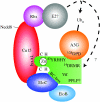APOBEC proteins and intrinsic resistance to HIV-1 infection
- PMID: 19038776
- PMCID: PMC2660912
- DOI: 10.1098/rstb.2008.0185
APOBEC proteins and intrinsic resistance to HIV-1 infection
Abstract
Members of the APOBEC family of cellular polynucleotide cytidine deaminases, most notably APOBEC3G and APOBEC3F, are potent inhibitors of HIV-1 infection. Wild type HIV-1 infections are largely spared from APOBEC3G/F function through the action of the essential viral protein, Vif. In the absence of Vif, APOBEC3G/F are encapsidated by budding virus particles leading to excessive cytidine (C) to uridine (U) editing of negative sense reverse transcripts in newly infected cells. This registers as guanosine (G) to adenosine (A) hypermutations in plus-stranded cDNA. In addition to this profoundly debilitating effect on genetic integrity, APOBEC3G/F also appear to inhibit viral DNA synthesis by impeding the translocation of reverse transcriptase along template RNA. Because the functions of Vif and APOBEC3G/F proteins oppose each other, it is likely that fluctuations in the Vif-APOBEC balance may influence the natural history of HIV-1 infection, as well as viral sequence diversification and evolution. Given Vif's critical role in suppressing APOBEC3G/F function, it can be argued that pharmacologic strategies aimed at restoring the activity of these intrinsic anti-viral factors in the context of infected cells in vivo have clear therapeutic merit, and therefore deserve aggressive pursuit.
Figures




References
-
- An P., et al. APOBEC3G genetic variants and their influence on the progression to AIDS. J. Virol. 2004;78:11 070–11 076. doi:10.1128/JVI.78.20.11070-11076.2004 - DOI - PMC - PubMed
-
- An P., et al. Polymorphisms of CUL5 are associated with CD4+T cell loss in HIV-1 infected individuals. PLoS Genet. 2007;3:e19. doi:10.1371/journal.pgen.0030019 - DOI - PMC - PubMed
-
- Anant S., Davidson N.O. Molecular mechanisms of apolipoprotein B mRNA editing. Curr. Opin. Lipidol. 2001;12:159–165. doi:10.1097/00041433-200104000-00009 - DOI - PubMed
-
- Anderson J.L., Hope T.J. APOBEC3G restricts early HIV-1 replication in the cytoplasm of target cells. Virology. 2008;375:1–12. doi:10.1016/j.virol.2008.01.042 - DOI - PMC - PubMed
-
- Betts L., Xiang S., Short S.A., Wolfenden R., Carter C.W., Jr Cytidine deaminase. The 2.3 A crystal structure of an enzyme: transition-state analog complex. J. Mol. Biol. 1994;235:635–656. doi:10.1006/jmbi.1994.1018 - DOI - PubMed
Publication types
MeSH terms
Substances
Grants and funding
LinkOut - more resources
Full Text Sources
Other Literature Sources
Medical
